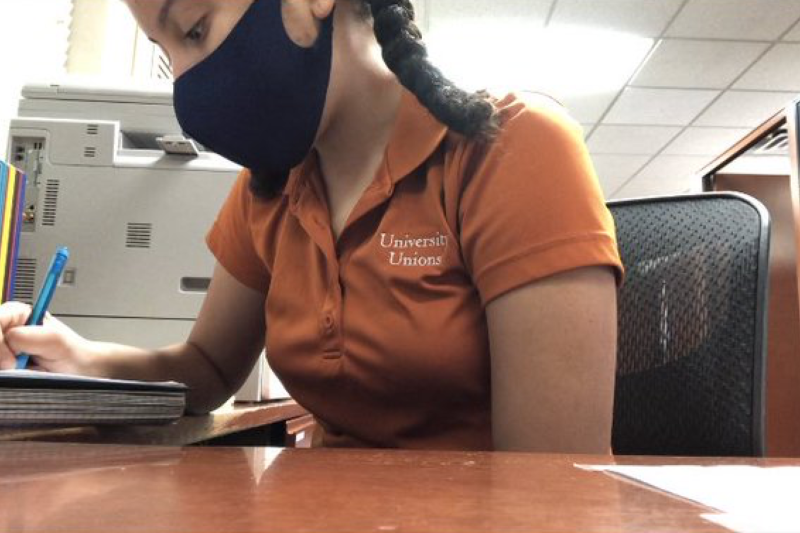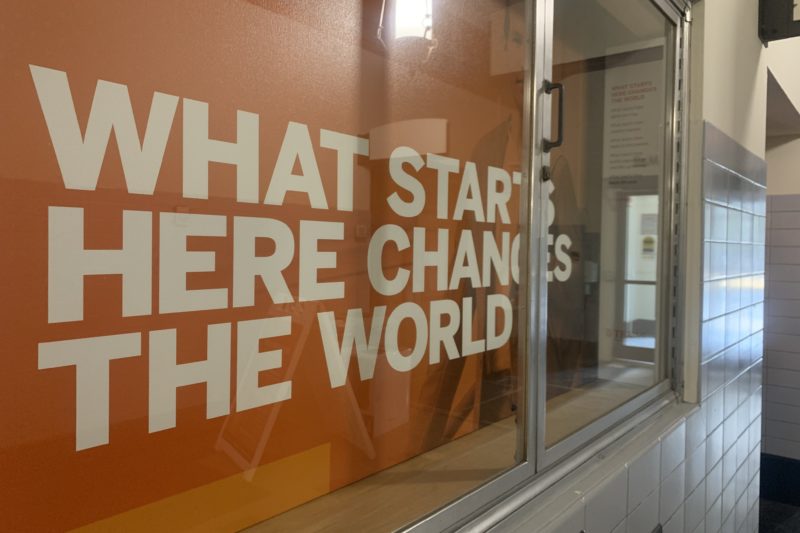A year into COVID-19, UT’s non-white, low income students feel left behind
By Alyssa Weinstein and Alyssa Quiles
Reporting Texas

Photo courtesy of Yliana Roland
Yliana Roland, an 18-year-old student University of Texas at Austin student, was raised in Houston in a low-income community of color in which mental health was a taboo topic often swept under the rug.
It wasn’t until she first arrived on campus during the pandemic this year that she was formally exposed to mental health awareness. Yet, from a campus that prides itself on its mantra of “What Starts Here Changes the World,” Roland and many other non-white, low income students feel they have been left behind, both mentally and emotionally, leaving one university official to decry, “The students are in survival mode.”
“Starting college in a pandemic was difficult,” Roland said. “It’s been about a year since this all started and I almost forgot that there wasn’t a time that we were living in a pandemic.”
Interview with Yliana Roland
Now, as a biracial freshman during a pandemic, Roland said her feelings of depression and anxiety heightened the realization she needed professional help.
Roland was only granted five free sessions from UT’s Counseling and Mental Health Center. Now that her sessions are depleted, Roland is left in an overwhelming and expensive mental health care system to navigate alone as she tries to find her next therapist.

As the university continues to heavily promote its motto for worldwide change and betterment, it’s failing to recognize the proper care of its core constituency – the mental wellbeing of students, especially during crises such as the pandemic.
According to a New York Times article, mental health research is only just beginning to uncover how the global COVID-19 pandemic has impacted the mental health of college students. About 26 million college students’ lives were obstructed by having to cope with dorm room confinement during quarantine, lack of healthy social lives and exercise all while still attending school full-time, the article said.
With the countless pitfalls college students had to grapple with this past year, the question arises of how UT Austin has cared for their students’ mental health – especially their students of color who already face mental health care access disparities.
The American Psychiatric Association reported that these disparities can be caused by different rates of income, cultural stigmas, accessibility to health care or the health care system’s lack of multilingual services.
According to the APA, only one-in-three African Americans who need mental health care actually receive it. For Hispanics and Latinos, U.S.-born Hispanics report higher rates for most psychiatric disorders than Hispanic immigrants, and Hispanic youth are more vulnerable to psychological stress rooted in acculturation. Also, APA says Asian-Americans and other minority groups are least likely to seek mental health care due to mental illness possibly being considered an expression of weakness or burden within their communities.
While growing up with no mental health resources around her, Roland began to realize she was having unusual and overwhelming feelings that she didn’t know how to identify. After doing some independent research when younger, the student realized she was struggling with anxiety and depression and didn’t even know it
With an unstable health insurance status and very limited funds, Roland’s only option was the limited free sessions UT’s Counseling and Mental Health Center offers students.
According to UT’s CMHC’s website, students are assessed differently dependent on their needs.
“Eligibility to individual counseling services may vary due to severity, appropriateness of services, and availability of resources,” the website states. However, from Roland’s experience with CMHC, she said the standard number of CMHC sessions for UT students is about three.
After her time at CMHC was done, Roland’s former therapist gave her a list of different inexpensive resources in Austin for Roland to explore – and UT isn’t on that list
“It’s discouraging. Once I find a new resource to explore, [I] might not be able to use it for long because there’s a waitlist. There’s a lot of people who need it, too,” Roland said.
As Roland struggles to find another avenue of mental health care, she also has mixed emotions seeing her peers easily able to find what they need for their troubles.
“[I] see others that are able to drop thousands of dollars on fixing their issues and it’s enraging because they’re making progress and [I’m] not. Everything is so limited, though right now, there is only so much [I] can do,” Roland said.
On a daily basis, Liliana Martinez, pipeline coordinator of the Office of Diversity, Equity and Inclusion at UT Austin Dell Medical School, sees firsthand how undergraduate students of color and from lower-income backgrounds navigate mental health care access during COVID-19.
“[The students] are in survival mode,” Martinez said. “Survival mode doesn’t always include asking for help or even acknowledging that you can get help and one day it’s going to come crashing down.”
Dr. Rene Salazar, assistant dean for diversity at Dell Medical School at UT Austin, says it’s enraging for him, too, as a primary care doctor to hear students like Roland struggling during already such a difficult time.
If the university is going to push their tagline of “What Starts Here Changes the World”, Salazar said we must start fixing our own issues.
“Your budget is your value system,” Salazar said. “If at the end of the day our goal is to create and produce students that are going to succeed, we have to commit to the welfare of those students.”
From the past few years Martinez has worked with these students at UT, she has realized the university needs to go beyond just their academics for students.
“When you throw [these students] into the mix of a situation with being away from home and family, it creates the imposter syndrome of doubtfulness in the value [of their work],” Martinez said.
Interview with Liliana Martinez
Martinez says that once students graduate and leave the 40 acres, the students will still be claiming themselves as UT-affiliated years later. “They need investment in their well-being and their mental health in order to be successful long-term.”
The university has plenty of resources, professionals, the Dell Medical School, UT Health Austin, professors, departments, Martinez said. At the end of the day, however, the decision to reallocate the funds to help these students is left to the higher-ups.
It’s easier said than done to just point to the people in charge and say to just allocate more money, Dr. Salazar said. But he wonders if the university could consider starting special campaigns for this issue or to spread awareness about it because he believes there are people who would support mental health care efforts for students of color or lower socioeconomic status.
“How do we do the right people are aware of this? Then how to make sure change happens,” Dr. Salazar asks. “These are all parts of the solutions to this complicated issue.”
As Roland continues to unpack Austin’s exhaustive mental health care system alone, she agrees that serious work needs to be done for young students of color so they don’t have to go through what she has experienced.
“It’s a complex issue…that I think is rooted in systemic racism,” Roland said. “Let’s be honest, primarily white communities having better access to things.”